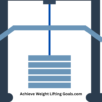Achieving your weigh lifting goals requires a framework that looks like the following :
I. Writing a Well-Formed Outcome
Example: Go from Increase my bench press by 20 pounds within 12 weeks to Bench press 170 pounds for 2 reps on 6/7/2023.
II. Dates and Measurements
Starting date: March 15, 2023 Ending date: June 7, 2023 Measurement type: Weight lifted Starting metric: 150 pounds Ending metric: 170 pounds Short-term goal: Increase bench press by 5 pounds each week Long-term goal: Increase bench press by 20 pounds within 12 weeks
III. Set Milestones
Milestone 1: Bench press 155 for 2 reps (by March 22, 2023) Milestone 2: Bench press 160 by (by April 12, 2023) Milestone 3: Bench press 165 for 2 reps within 8 weeks (by May 10, 2023) Milestone 4: Bench press 170 pounds for 2 reps (by June 7, 2023)
IV. Resources Needed
People: A personal trainer or workout partner for guidance and motivation Money: Gym membership, workout equipment, supplements Advice: Research on proper form, nutrition, and training techniques
V. Why the Goal is Important
Underlying motivation: To improve strength and overall fitness Personal values: Dedication to self-improvement and personal growth Beliefs: Belief in the benefits of weightlifting and bodybuilding for physical and mental health Desires: Desire for a stronger, healthier, and more confident body.
Along with these goals, include visualization elements as well.
Visualization is a powerful tool that can help you achieve your goals, including increasing your bench press strength. Here are some steps you can follow to use visualization to help you bench press 250 pounds:
- Create a clear mental image of yourself bench pressing 250 pounds. Visualize the weight on the bar, the position of your hands, the feeling of the weight in your hands, and the movement of the bar as you push it up and lower it back down.
- Visualize the feeling of strength and power in your body as you lift the weight. Feel your muscles contracting and working together to lift the weight, and feel the rush of adrenaline as you complete the lift.
- Imagine the taste of victory as you successfully complete a set of 250-pound bench presses. Imagine the feeling of accomplishment and pride as you reach this milestone.
- Use all of your senses to create a vivid mental image of yourself achieving your goal. Imagine the sounds of the weights clanking together, the smell of the gym, and the feeling of the bench beneath you as you lift.
- Break down your goal into smaller milestones and visualize yourself achieving each one. For example, visualize yourself bench pressing 150 pounds, then 200 pounds, and so on. Celebrate each milestone as you achieve it and use it as motivation to keep going.
Remember to be consistent and persistent in your visualization practice. The more you visualize yourself achieving your goal, the more real it will become in your mind, and the more motivated you will be to make it a reality in the gym.
VI. Accountability
A powerful tool for achieving your fitness goals, including increasing your bench press strength. Here are some steps you can follow to use accountability and accountability partners to help you bench press 250 pounds:
- Find an accountability partner who shares your fitness goals and is committed to helping you reach them. This could be a friend, family member, or a fellow gym-goer.
- Set specific goals and timelines for your bench press progress and share them with your accountability partner. This will help keep you both on track and motivated to achieve your goals.
- Create a system for tracking your progress and share it with your accountability partner. This could be a workout journal or an app that tracks your lifts and progress over time.
- Hold each other accountable by checking in regularly and providing support and motivation. This could be through in-person meetings at the gym, phone calls, or text messages.
- Use visualization to imagine your accountability partner as someone who is supportive, encouraging, and motivating. Picture them as someone who will push you to reach your potential and help keep you accountable to your goals.
- Lastly, be sure to celebrate your progress and achievements together. Whether it’s hitting a new personal record or achieving a milestone, take the time to acknowledge and celebrate your hard work together.
Remember that accountability is a two-way street, so be sure to also support and motivate your accountability partner as they work towards their own fitness goals. Together, you can achieve great things and reach your bench press goals.
VII. Spreadsheets to monitor success:
- Regularly update your spreadsheet to track your progress towards each goal. Use a color-coded system to indicate whether you’re on track, falling behind, or ahead of schedule.
- Use your spreadsheet to monitor your accountability by scheduling regular check-ins with yourself or an accountability partner. Use this time to review your progress, identify any roadblocks, and adjust your plan as necessary.
- Celebrate your achievements and learn from any setbacks. Use your spreadsheet to document your successes and areas for improvement, and use this information to inform your goals and actions for the next 12-week cycle.
Overall, using a spreadsheet to monitor your accountability can help you stay on track and focused on your goals. It provides a visual representation of your progress and helps you stay motivated and accountable to yourself and others.
